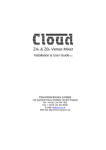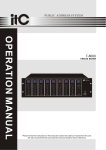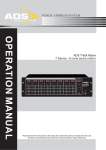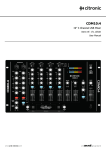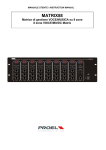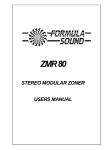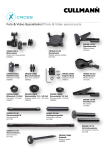Download CX122 User Guide [manual]
Transcript
CX122 Mixer Zoner User Guide General Description The CX122 is a versatile mixer-zoner that can be used with confidence as part of a professional sound system. The impressive performance and flexible routing options, together with the remote level control facility make it suitable for a wide range of applications. In addition, the fire alarm mute facility with emergency microphone circuitry make the unit well equipped to satisfy local authority and fire department requirements. The front panel controls are easy to understand and simple to operate and the unit can be confidently operated by unskilled personnel. All the routing, gain and equalisation controls are positioned on the rear panel, with the exception of the front panel mounted microphone EQ which have removable shafts. Input Routing The two music inputs,together with the microphone input can be routed to the two output zones with some flexibility. The microphone and Line 1 inputs are permanently routed to Zone 1 output,and in addition, Line 2 input can be routed to Zone 1 by selecting the switch located on the rear panel. All three inputs can operate through Zone 2 in any combination by selecting the respective routing switch on the rear panel. Music Inputs Music inputs The two stereo line inputs have a flat frequency response and are suitable for most music sources such as compact disc players, tape players and radio tuners etc. Inputs are unbalanced, using RCA phono sockets and the nominal input sensitivity is 0dBu (775mV) ±12dB with an impedance of 100kΩ. Gain control The two stereo line inputs have pre-set gain controls mounted on the rear panel, adjacent to the input sockets. The range of control is ±12dB. As the nominal input sensitivity is 0dBu (775mV), the input sensitivity can be varied from -12dBu (195mV) to +12dBu (3.08V) and each gain control should be set to allow the front panel level controls to have an optimum range of control. Front panel level controls These controls simply set the levels of the music source and the self adhesive labels supplied with the unit can be positioned above the controls to clearly identify the source. Priority Line 1 input has a provision to provide priority over Line 2 input. The priority switch is positioned on the rear panel adjacent to Line 1 input sockets. When the priority is active, a signal present on Line 1 will automatically over-ride Line 2. A typical application is where a juke box signal (Line 1) is required to over-ride the background music signal (Line 2). There is a delay of approximately 15 seconds before the Line 2 signal is restored. If the factory default delay of 15 seconds is too long for the application, an internal jumper can be configured for alternative release times of 6 or 3 seconds. Microphone Inputs Mic inputs One microphone input is provided and the microphone amplifier is an electronically balanced, transformerless design configured for optimum low noise performance. The input impedance is greater than 2kΩ and is suitable for microphones in the 200Ω to 600Ω range. The input is via a gold plated 3 pin XLR type connector with latch and is located on the rear panel. To operate the channel in the unbalanced mode, it is suggested that pin 3 be connected to the ground terminal (pin 1) inside the XLR cable plug. Gain Control A pre-set gain control is provided adjacent to the input connector. The gain can be adjusted from 0dB to 60dB of gain. The wide range of gain allows direct connection of high output devices such as radio microphones without the need for input attenuators. A high overload margin is maintained at all gain settings. Front Panel Level Control This control is provided for the user to set the desired signal level. It is suggested that the gain control on the rear panel is set at a level where excessive gain cannot be obtained with the front panel control in the fully clockwise position. Self adhesive labels are provided and if appropriate can be placed above the level control. Priority The microphone input has a switchable priority option. When the microphone is being used with the priority switched on, any music signal present will be attenuated automatically. Normal music operation will be restored smoothly after the announcement has been made. The priority switch is positioned adjacent to the microphone gain control on the rear panel. Equalisation Comprehensive equalisation is provided for the microphone signal. The front panel mounted treble and bass controls have a range of ±10dB at 5kHz and 100Hz respectively and in addition, a high pass filter operating at 100Hz reduces undesirable low frequency breath blasts and handling noise. If required, the microphone equalisation control spindles complete with knob can be removed and the supplied blanking plugs can be fitted to preserve the settings. Remote Music Mute When the CX122 is connected to a fire alarm control panel via the remote music mute connector, an alarm condition will reduce the level of the music signals to allow the alarm sounders to be heard and in addition, the microphone channel will be routed directly to the two output zones, allowing the microphone to operate irrespective of the condition of any level controls or routing switches (including VCA). This allows the microphone to be used to organise a controlled evacuation. The emergency microphone level can be set internally by adjusting the pre-set potentiometer PR1. Zone Outputs Zone outputs The two stereo zone outputs are balanced and can operate with loads as low as 600Ω. 3 pole ¼"(6.35mm) jack sockets are used for all outputs. The nominal output level is 0dBu (775mV) but the CX122 can operate satisfactorily with a wide range of signal levels up to a maximum output of +20dBu. If you wish to connect any zone output to an unbalanced input, 2 pole jack plugs should be used. Equalisation Both output zones have independent treble (HF) and bass (LF) controls and these are positioned adjacent to the output sockets on the rear panel. The treble control has a range of ±10dB at 10kHz and the bass control has ±10dB at 50Hz. These controls can be used to provide compensation for differing acoustics or loudspeaker types. Stereo/Mono Operation All CX122's leave the factory configured for stereo operation. By configuring circuit jumpers mounted on the PCB adjacent to the output sockets, each output zone can be configured to operate in the mono mode. When operating in the mono mode, the output signal is present on both the left and right output sockets and either or both may be used. VCA Modules VCA modules Local control of the signal level can be achieved on either or both of the zone outputs by fitting optional VCA modules. These compact modules utilise a pair of industry standard low distortion VCA's and simply plug into the printed circuit board. The modules can be retro-fitted but the CX122 would normally be supplied with the modules fitted if specified at the time of ordering. Fitting VCA Modules 1. Before commencing any work, the CX122 power cable must be disconnected. 2. Remove the CX122 top panel. 3. The position of the VCA modules is clearly shown on the printed circuit board. Locate the 10 pin male connector, this should have each end pair of pins shorted by single circuit jumpers. Remove these two jumpers. 4. Carefully position the VCA module on to the 10 pin connector, making sure that both rows of pins engage with the module mounted socket. This can be verified by checking the alignment of the 3mm fixing hole. When you are satisfied that the VCA module is correctly fitted, secure the module with the supplied M3 screw. 5. If you wish to bypass the respective front panel zone level control, the circuit jumpers adjacent to the respective control can be configured as detailed on the printed circuit board. This isolates the front panel control from the circuitry, leaving the remote level control to operate independently. 7. Refit the top panel. Remote Level Plate A remote level plate complete with control is supplied with each VCA module and this can be fitted directly onto a standard UK electrical single gang mounting box (recessed or surface) with a minimum depth of 25mm (not supplied). Two core screened cable should be used to link the remote level control to the CX122. When the remote level control facility is being used, it may be desirable to defeat the front panel zone level control and this can be achieved by configuring an internal jumper. REMOTE LEVEL CONTROL WIRING DETAILS Fire Alarm Interface (Remote Music Mute) In certain circumstances, there may be a local authority or fire service requirement to mute the music signals via a fire alarm control panel in an alarm condition. The CX122 provides a facility to attenuate the music signals, by using a fully floating (isolated) pair of contacts in the control panel which would need to be closed during an alarm condition. In the mute mode, a gain reduction of 20dB is effective on the music signals only. The microphone channel automatically switches to the emergency mode and will operate on both zone outputs irrespective of the routing, level control and VCA module settings. A pre-set potentiometer (PR1) mounted on the PCB can be adjusted to give the required microphone level in the emergency mode. It should be noted that in order to avoid a panic situation, the music muting reduces the gain over a period of approximately 10 seconds. The recovery is also subject to a similar delay. General Notes Earthing The 0V rail on the CX122 is connected to the mains earth and the unit must be earthed. Under no circumstances should the mains earth be disconnected to remedy earth loop hums. If a mains powered signal source is used which is also earthed, then earth or ground loop hums may cause problems. The 'hum' can be remedied in several ways. If a problem is caused by the link to power amplifiers, using balanced connections with the cable screen only connected at the receiving end may reduce the noise. Alternatively, re-route the mains supply of the equipment to the same point as that of the CX122. (Note: Microphone cables must be earthed at both ends). Rack Mounting The CX122 can be mounted in a standard 19" equipment rack and occupies 1U of space. Avoid mounting the unit in close proximity to large power amplifiers which may radiate substantial magnetic fields and heat. Earth loops may also cause problems when several units are mounted on a common fixing rail. The use of insulating screw cups together with nylon spacers can solve the problem. SAFETY CONSIDERATIONS CAUTION - MAINS FUSE To reduce the risk of fire, replace the mains fuse only with the same type, which must be a class 3, 240 Volt, time delay type, rated at 50mA where the mains input voltage is set to 220240 Volts AC. For a mains voltage of 110-120 Volts AC, the fuse should be rated at 100mA. The fuse body size is 20mm x 5mm. CAUTION - SERVICING This unit contains no user serviceable parts. Refer servicing to qualified service personnel. Do not perform any servicing unless you are qualified to do so. WARNING To reduce the risk of fire or electric shock, do not expose this unit to rain or moisture.





